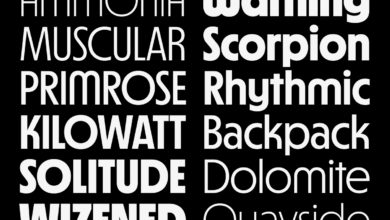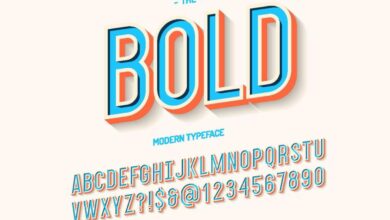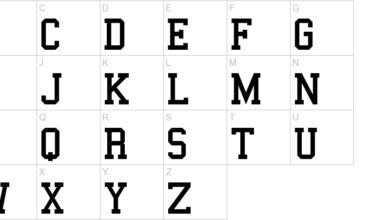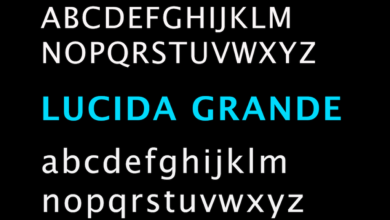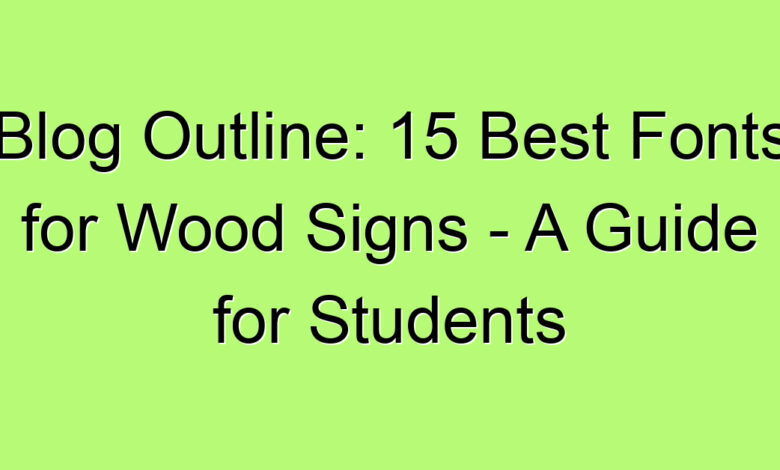
Best Fonts for Wood Signs A Rustic Guide
Best fonts for wood signs? It’s more than just picking a pretty typeface; it’s about creating a visual masterpiece that’s both legible and aesthetically pleasing. The right font can transform a simple piece of wood into a charming farmhouse sign, a rustic welcome message, or a stylish statement piece for your home. We’ll dive into the world of serif, sans-serif, and script fonts, exploring font weights, sizes, and how different wood types influence your choices.
Get ready to discover the perfect font for your next wood sign project!
This post will guide you through selecting the ideal font for your wood sign, covering everything from rustic charm to modern farmhouse styles. We’ll explore font styles, sizes, readability, and material compatibility, ensuring your message is clear and captivating. We’ll also look at specific examples for different sign types, like wedding signs, business signs, and home decor signs. Let’s get crafting!
Font Styles for Rustic Appeal
Choosing the right font for a wood sign is crucial for achieving the desired aesthetic and ensuring readability. The rustic charm of a wood sign is often enhanced by the careful selection of typography, balancing visual appeal with practicality. The font should complement the natural texture and warmth of the wood, creating a cohesive and eye-catching piece.
Serif Fonts for Readability at a Distance
Serif fonts, with their small decorative strokes at the ends of letters, often lend themselves well to wood signs, particularly when readability from a distance is important. Their classic feel aligns perfectly with the rustic aesthetic. Imagine three different wood signs:
Mockup 1: A sign featuring the font “Playfair Display” announces “Welcome to Our Farm”. The elegant serifs and slightly condensed letterforms provide a sophisticated yet rustic feel, ensuring the text remains clear even from afar. The slightly high contrast between thick and thin strokes adds visual interest without sacrificing legibility. The dark brown lettering stands out sharply against the light-colored wood.
Mockup 2: A sign using “Times New Roman” proclaims “Smith Family Orchard”. This classic serif font offers excellent readability, making it suitable for longer text. Its familiar and timeless appearance adds to the rustic charm of the wood. The consistent stroke weight creates a sense of balance and order, suitable for a more traditional sign. The sign is painted in a muted green, contrasting nicely with the wood grain.
Mockup 3: A sign displaying “Handcrafted with Love” in “Garamond” font. Garamond’s subtle serifs and slightly more open letter spacing contribute to its elegant and approachable appearance. This is a great choice for signs requiring a touch of refinement. The soft white paint complements the warm tones of the wood and makes the text easily visible.
Script versus Sans-Serif Fonts on Wood Signs, Best fonts for wood signs
Script fonts, with their flowing, cursive-like appearance, can add a touch of elegance and whimsy to a wood sign. However, their readability can be compromised, especially from a distance or with intricate designs. Sans-serif fonts, lacking those decorative strokes, offer a cleaner, more modern look. They are generally easier to read, making them suitable for signs requiring clear, concise messaging.
The contrast is stark: a script font might be perfect for a romantic, personalized message, while a sans-serif font is ideal for directional signage or a more contemporary aesthetic.
Font Weight’s Impact on Wood Sign Aesthetics
Font weight significantly influences the overall aesthetic of a wood sign. A bold font commands attention and makes a statement, ideal for a prominent sign or a message that needs to stand out. A light font conveys a more delicate, subtle feel, better suited for smaller signs or more understated messages. Regular weight fonts offer a balanced approach, combining readability with a less aggressive visual impact.
The choice depends on the message and the desired overall impression. For example, a bold font might be used for a business name, while a lighter font might be better for a decorative element.
Comparison of Serif Fonts for Wood Signs
| Font Name | Characteristics | Readability | Potential Applications |
|---|---|---|---|
| Playfair Display | Elegant serifs, slightly condensed, high contrast | Excellent | Business names, welcome signs, sophisticated messages |
| Times New Roman | Classic serif, consistent stroke weight, highly legible | Excellent | Informational signs, longer text, traditional designs |
| Garamond | Subtle serifs, open letter spacing, elegant and approachable | Good | Decorative elements, short messages, refined aesthetics |
Font Size and Readability
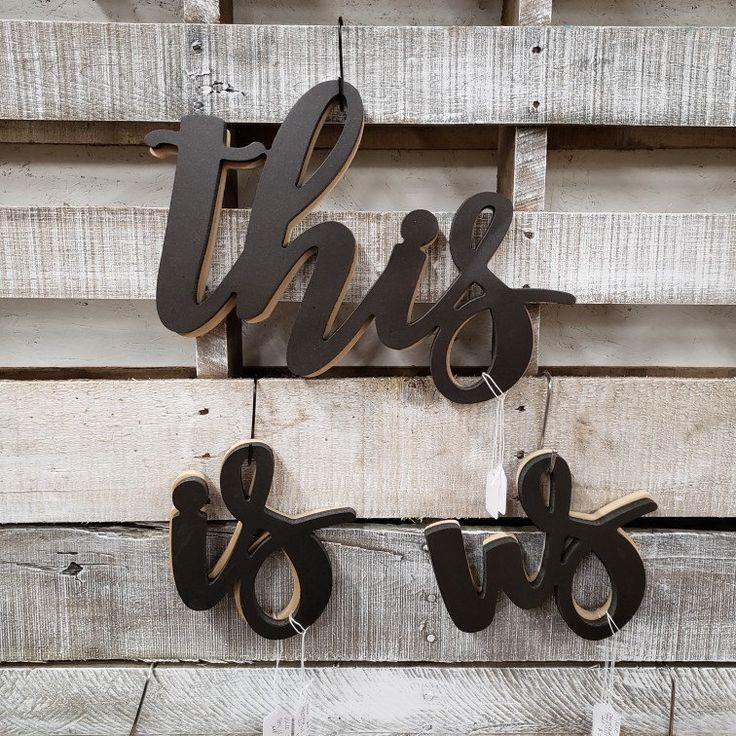
Source: pinimg.com
Choosing the right font size for your wood sign is crucial for ensuring its message is clear and easily read. It’s not just about aesthetics; readability directly impacts the effectiveness of your sign. Getting this wrong can mean your carefully crafted message is lost on the viewer, defeating the entire purpose of creating the sign in the first place.
This section will explore the factors influencing font size selection and provide practical guidance for optimal readability.Font size selection depends heavily on viewing distance and sign dimensions. A larger sign viewed from a distance requires a larger font size than a smaller sign viewed up close. Think of a highway billboard versus a small shop sign. The billboard needs much larger lettering to be legible from a distance of several hundred feet, while the shop sign, viewed from a few feet away, can use a considerably smaller font.
Choosing the best fonts for wood signs is all about that perfect rustic vibe, right? I’ve been experimenting lately, and to get some inspiration for my video tutorials, I checked out some great tips on getting it on with youtube – seriously, their advice on video editing helped me tons! Now I can show off my gorgeous wood sign font choices much better.
Back to fonts – I’m currently loving the classic feel of Playfair Display for a more elegant look.
Ideal Font Size Ranges
A general guideline is to aim for a minimum font size that allows for easy reading from the average viewing distance. For signs viewed from a distance of 10-15 feet, a minimum font height of 1.5 to 2 inches is recommended. For closer viewing distances (3-5 feet), a font size of 0.75 to 1 inch might suffice. However, these are just starting points.
The optimal size also depends on the length of the text, the font style itself, and the overall design of the sign. A bolder font, for example, might be readable at a slightly smaller size than a thinner, more delicate font. Consider using a larger font size for longer phrases to improve readability. A sign with a 30-word phrase would require a larger font size than a sign with a 5-word phrase, even if the signs are of similar dimensions.
Kerning and Letter Spacing’s Impact on Readability
Kerning (adjusting the space between individual letter pairs) and letter spacing (adjusting the space between all letters) significantly affect readability, especially in different font sizes. On smaller signs, slightly increasing letter spacing can improve readability, making the letters less cramped and easier to distinguish. Conversely, on larger signs, tighter kerning might enhance the overall aesthetic appeal without sacrificing readability.
For example, a tightly kerned font on a large, rustic-style sign might add to its charm, whereas the same tight kerning on a small sign could make the text look cluttered and difficult to read. Experimentation is key to finding the optimal balance between aesthetics and readability.
Using Different Font Sizes for Multiple Lines of Text
For wood signs with multiple lines of text, varying font sizes can be used to create visual hierarchy and improve readability. A larger font size for the main message or title draws the eye, while a smaller font size can be used for secondary information or a tagline. For instance, a restaurant sign might use a large font size for “The Cozy Cafe” and a smaller font size for “Breakfast, Lunch & Dinner.” This creates a clear visual separation and helps the viewer quickly understand the sign’s message.
The difference in font size should be noticeable but not jarring. A good rule of thumb is to maintain a consistent aspect ratio between the sizes used for different lines of text.
Example: Long Phrase Sign Design
Let’s say we need a wood sign with the phrase: “Welcome to our charming little farmhouse, nestled amongst rolling hills and blooming meadows.” This is a long phrase, requiring careful consideration of font size and line breaks for optimal readability. Using a rustic-style serif font like Playfair Display, a font size of 1.25 inches for the first line (“Welcome to our charming little farmhouse”) and 1 inch for the second line (“nestled amongst rolling hills and blooming meadows”) would be suitable for a sign that will be viewed from about 5-7 feet away.
The line spacing should be approximately 0.75 inches to avoid the lines feeling cramped. The overall sign size should be adjusted accordingly to accommodate the chosen font size and line spacing. This ensures the text is not only readable but also visually pleasing within the design constraints of the sign.
Font Legibility and Material Compatibility
Choosing the right font for your wood sign isn’t just about aesthetics; it’s about ensuring your message is clear and easily read, regardless of the wood type or finish. The texture and color of the wood, along with any staining or painting techniques, significantly impact font visibility. Let’s dive into how to select fonts that maximize legibility on various wood surfaces.
The interplay between font choice and wood characteristics is crucial for a successful sign. A font that looks stunning on smooth, light-colored pine might be almost invisible on dark, heavily textured reclaimed wood. Conversely, a font perfectly suited for a rustic oak sign might appear too clunky on a sleek, painted surface. Understanding these interactions is key to creating a sign that’s both beautiful and functional.
Fonts Suitable for Various Wood Types
Three fonts that consistently offer high legibility across different wood types are Arial, Times New Roman, and Bebas Neue. Arial, with its clean lines and consistent spacing, works well on almost any wood, from smooth pine to rough-hewn oak. Times New Roman, a classic serif font, offers excellent readability even on darker woods or those with a more pronounced grain.
Bebas Neue, a sans-serif font with bold strokes, is ideal for situations where high contrast is needed, such as on heavily textured or darkly stained wood. Its simplicity makes it highly readable even at smaller sizes.
Wood Texture and Color’s Influence on Font Choice
The texture and color of the wood significantly affect font visibility. Rough, heavily textured woods like reclaimed barn wood require fonts with bolder strokes and wider spacing to prevent letters from blending together. Lighter-colored woods allow for a wider range of font styles and colors, while darker woods necessitate higher contrast between the font and the background. For example, a delicate script font might be lost on dark oak, whereas it would be perfectly legible on light pine.
Similarly, a light-colored font on dark wood will require a larger size or bolder stroke weight to maintain readability.
Font Styles and Wood Finishing Techniques
Different wood staining and painting techniques also influence font selection. For example, a distressed paint finish might pair well with a slightly distressed or vintage-style font, while a clean, modern stain would benefit from a clean sans-serif font. A bold, blocky font would stand out against a rustic, whitewashed finish, while a more elegant serif font might be better suited to a polished, dark stain.
Consider the overall aesthetic you’re aiming for and choose a font that complements the finishing technique.
Font Characteristics for Enhanced Legibility on Wood
Several font characteristics significantly enhance legibility on wood surfaces. A higher x-height (the height of the lowercase ‘x’) improves readability, particularly in smaller font sizes. Sufficient spacing between letters (kerning) and lines (leading) prevents crowding and ensures each character is clearly distinguished. Bolder stroke weights (the thickness of the font’s lines) improve visibility, especially on darker or textured woods.
Finally, simple, clean fonts with minimal ornamentation are generally easier to read than highly decorative ones, particularly on uneven surfaces. The goal is to strike a balance between visual appeal and clarity.
Font Selection for Different Sign Styles
Choosing the right font is crucial for creating a wood sign that truly captures its intended style. The font should not only be legible but also aesthetically complement the overall design and the type of wood used. A mismatch can make even the most beautifully crafted sign look jarring and unprofessional.
Rustic Wood Sign Font Selection
For a rustic wood sign, imagine a weathered, reclaimed wood plank. We want a font that evokes a sense of age and craftsmanship, something that feels worn but not illegible. A great choice would be a serif font like Playfair Display or a slightly more distressed version of a classic serif like Times New Roman. These fonts, with their subtle flourishes and variations in stroke weight, perfectly capture the uneven texture and imperfections characteristic of rustic designs.
The use of decorative elements should be minimal; perhaps a subtle drop shadow to add depth without overwhelming the rustic simplicity. Overly ornate flourishes would clash with the intended feel. Think of a sign advertising a local farm or a quaint bed and breakfast – the font should feel homely and inviting, not overly fussy.
Modern Farmhouse Wood Sign Font Selection
Modern farmhouse style blends rustic charm with clean lines and a contemporary feel. For this style, a sans-serif font like Montserrat or Lato would be ideal. These fonts are clean and easily readable, yet they still possess a certain warmth and approachability. The key is to strike a balance between modern simplicity and rustic charm. A slightly textured or distressed effect applied to the font could subtly nod towards the rustic element, without sacrificing the clean lines that define the modern farmhouse aesthetic.
Consider using a slightly bolder weight for better readability, particularly if the sign will be viewed from a distance. While decorative elements like flourishes are generally avoided in modern farmhouse design, a simple drop shadow can add depth and visual interest without detracting from the clean aesthetic. Think of a sign displaying a family name or a welcoming message for a front porch – it should feel both stylish and welcoming.
Vintage Wood Sign Font Selection
For a vintage wood sign, we want to evoke a sense of nostalgia and history. Fonts like Bebas Neue or Pacifico would be excellent choices. Bebas Neue offers a bold, retro feel, while Pacifico provides a more handwritten, whimsical touch. The choice will depend on the specific vintage aesthetic you are aiming for. Decorative elements can play a significant role here.
Consider using flourishes or embellishments that complement the chosen font, adding to the vintage feel. Think of vintage advertisements or old-fashioned shop signs. A subtle distressed effect on the font or the background could further enhance the vintage look. A drop shadow could add depth, but keep it subtle to avoid overpowering the other decorative elements.
Imagine a sign advertising a vintage shop or a retro-themed event – the font should feel authentic and evocative of a bygone era.
Font Pairings for Different Wood Sign Styles
Font pairings can greatly enhance the overall design. The right combination can create visual harmony and emphasize the desired aesthetic.
- Rustic: Playfair Display (heading) paired with a simpler serif like Merriweather (body text).
- Modern Farmhouse: Montserrat (heading) paired with Open Sans (body text).
- Vintage: Bebas Neue (heading) paired with a script font like Great Vibes (body text, for a more handwritten look).
Visual Examples and Descriptions
Choosing the right font for your wood sign is crucial for conveying the desired message and aesthetic. The visual characteristics of a font—its texture, style, and overall feel—significantly impact the sign’s effectiveness. Let’s explore some examples for different applications.
Wedding Sign Font Characteristics
A wedding sign typically calls for a font that exudes elegance and romance. Imagine a script font, perhaps with subtle flourishes and a slightly textured appearance, reminiscent of calligraphy. The texture could be a slightly distressed or antiqued look, suggesting a vintage or handcrafted feel, without being overly rough. The style should be refined and graceful, perhaps with slightly connected letters for a flowing, romantic look.
Think of a font that evokes feelings of love, celebration, and timeless beauty. The overall effect should be sophisticated yet inviting.
Business Sign Font Characteristics
For a business sign, the font needs to be professional, legible, and memorable. A sans-serif font, clean and modern in style, would be a strong choice. The texture should be smooth and consistent, conveying professionalism and reliability. Avoid overly stylized or decorative fonts; instead, opt for a font that is easily readable from a distance, even in varying lighting conditions.
Think of a font that projects confidence and trustworthiness, reflecting the brand’s identity and values. The overall impact should be clear, concise, and impactful.
Home Décor Sign Font Characteristics
Home décor signs offer more flexibility in font selection. A playful, slightly quirky font could work well, perhaps with a slightly hand-drawn or vintage-inspired texture. The style could range from a whimsical script to a bold, slightly distressed sans-serif, depending on the overall décor theme. Think of fonts that evoke feelings of comfort, warmth, and personality. A slightly uneven or textured appearance can add to the rustic charm.
The overall impression should be inviting and reflect the homeowner’s unique style and taste. Perhaps a font that suggests a handmade quality, perhaps even mimicking a brushstroke or stencil effect.
Conclusion: Best Fonts For Wood Signs
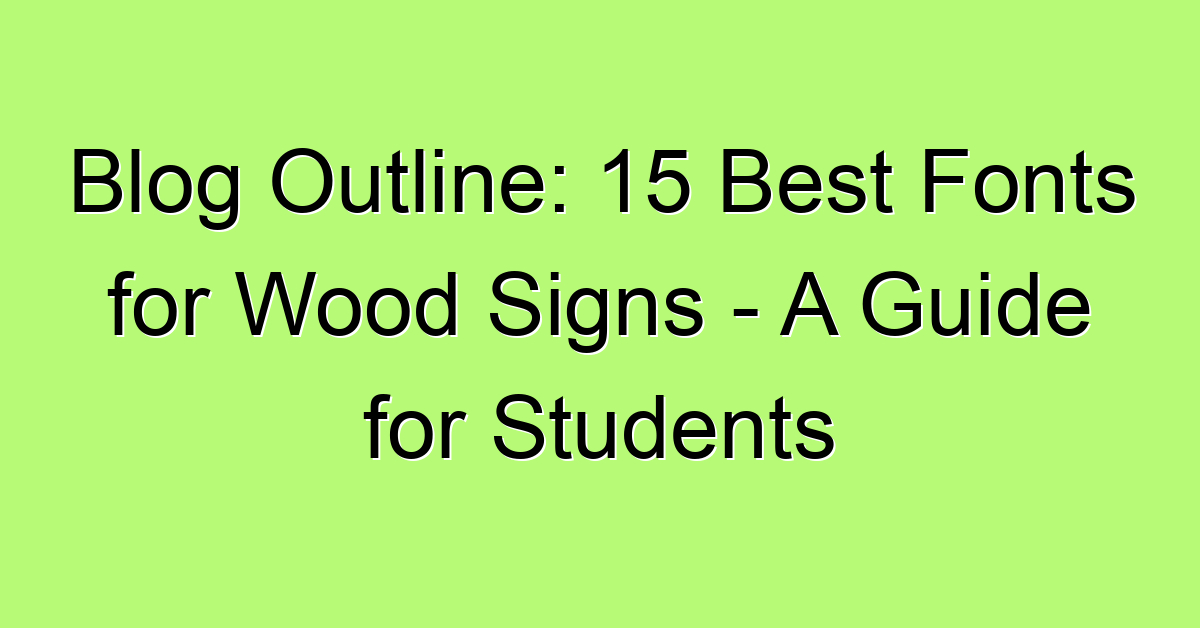
Source: fancyfonts.top
Choosing the best font for your wood sign is a journey of balancing aesthetics and readability. From the rustic charm of a serif font to the clean lines of a sans-serif, the perfect choice depends on your design style, the wood’s characteristics, and your message. Remember to consider font size, spacing, and the overall visual impact to create a sign that’s both beautiful and easy to read.
So, grab your tools, choose your font, and let your creativity flow! Happy crafting!
Query Resolution
What’s the best way to paint letters on a wood sign?
Use high-quality acrylic paints for vibrant, long-lasting results. Multiple thin coats are better than one thick coat to prevent cracking.
How do I prevent bleeding when painting letters on wood?
Use a primer on the wood first to create a smooth, even surface. Also, use a stencil and painter’s tape for clean lines.
Can I use a vinyl cutter to create my lettering?
Absolutely! Vinyl lettering offers a clean, professional look and is easy to apply. Choose a high-quality vinyl designed for outdoor use if needed.
What if my wood sign has a knot? How do I work around it?
Design your lettering to avoid the knot if possible. If it’s unavoidable, carefully paint around it or incorporate it into your design.
